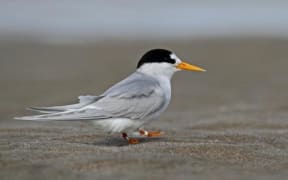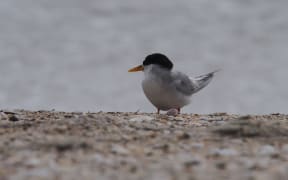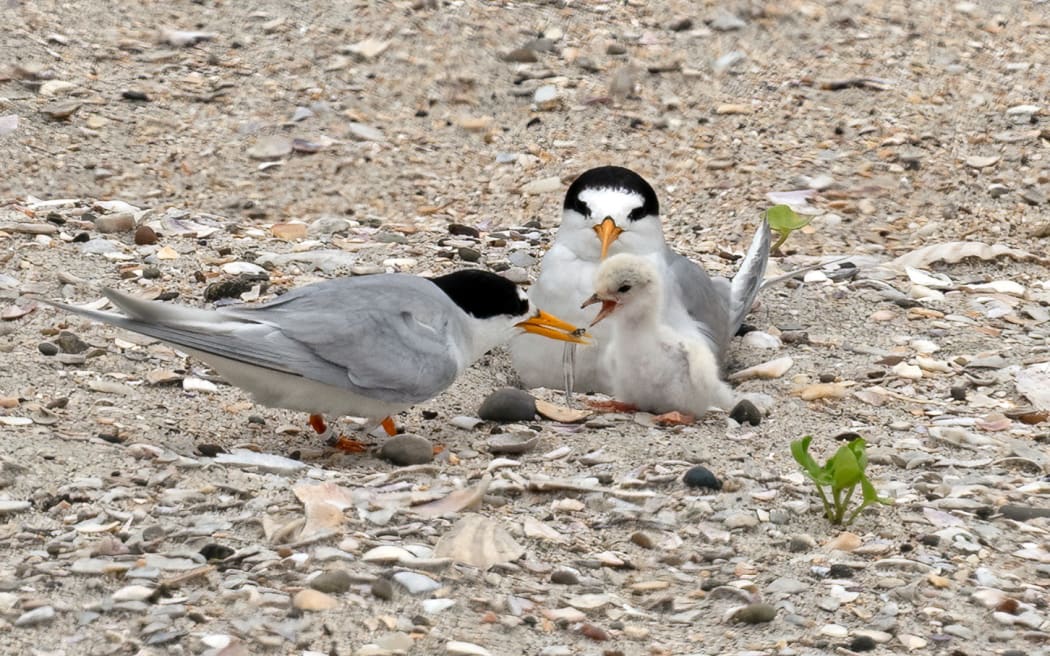
Dinner time! A doting adult tara iti, or fairy tern, offers its chick a freshly caught fish. Photo: Supplied / Darren Markin
New Zealand's rarest bird looks set for a bumper breeding season this summer with five fledglings already striking out on their own and as many as eight more chicks to follow.
That might not sound like many but given that the total world population of tara iti, or fairy terns, is less than 40, that is a huge boost to the species' chances of survival.
It is also a much-needed morale boost for volunteers and Department of Conservation staff looking after the birds, after the disastrous 2022-23 season in which Cyclone Gabrielle killed five adults and all but one chick.
DOC supervisor Shelley Ogle said the current season was tracking to be the best since 2013-14.
"So it's really lifted our spirits after last season, which was pretty devastating for us all."
Ogle said tara iti bred at only four locations - Papakanui, on the Kaipara Harbour, and at Pākiri, Mangawhai and Waipū, on the east coast, north of Auckland.
Ogle said the rare shorebird had relatives in Australia and New Caledonia, but the New Zealand sub-species was unique.
"There are fewer than 40 of them left, which makes them our most endangered endemic bird. They're incredibly threatened by all kinds of things," she said.
By comparison, the critically endangered kākāpō had a population of almost 250.
The key problem facing tara iti was that they liked the same environments as humans - sandy beaches with dunes and estuaries.
"They nest in shell and sand banks above the high tide mark on popular beaches, which makes them vulnerable to [predators] as well as disturbance by people, four-wheel drives and dogs," she said.
"And as we saw last season, they're also at massive risk from big tides and nasty storms. So they do have a lot against them. But luckily, we're putting a lot into them to try and protect them and bring those numbers up."
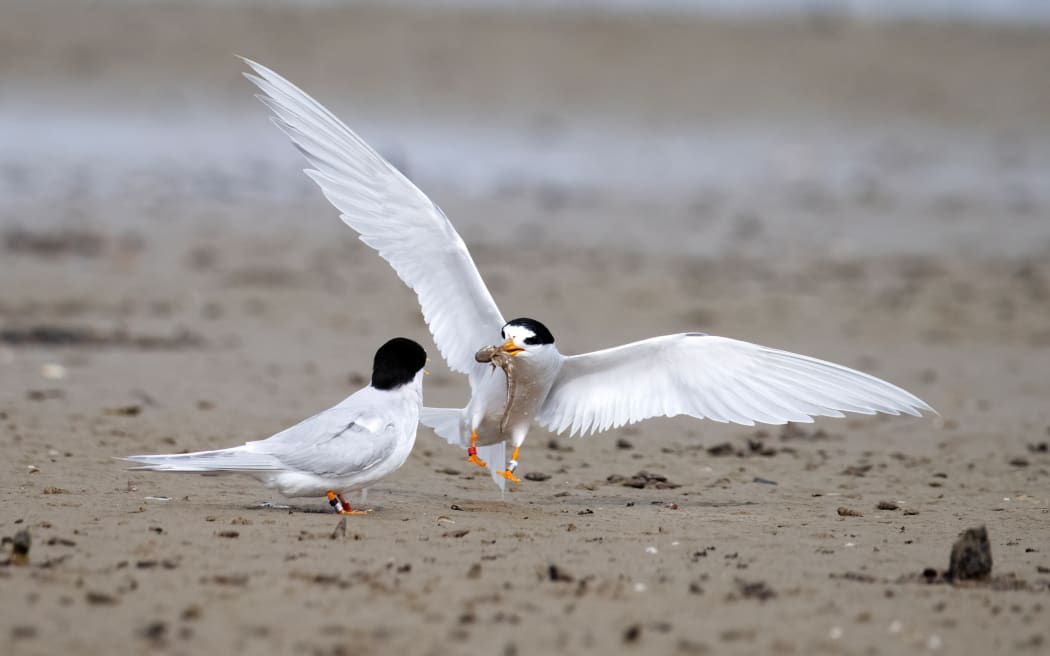
A tara iti, or fairy tern, returns to shore with its catch. Photo: Supplied / Darren Markin
Ogle said the birds were now nearing the end of their breeding season.
So far five chicks had fledged, or left the nest, with four more chicks still being raised by their parents. Another four were being raised in captivity and also looked promising.
"Last year we had Cyclone Gabrielle come through right at the end of the season, and while we had three chicks fledge, two of them perished along with five adults. And so we lost a massive portion of the population, which was pretty devastating."
It was too early to say if this year's bumper season would make up for last summer's losses.
Tara iti lived more than 20 years and did not start breeding until they were aged between two and four, so it would take some time before the newest additions made a real impact on the population.
In the meantime DOC staff, iwi, volunteers and contractors would keep working to give them the best chance possible of reaching breeding age.
That included ongoing predator control and monitoring of nest sites.
"And then just before the breeding season starts we'll enhance the habitat and create safer areas for them to nest in. Some sites are prone to being flooded in really high tides, so we'll create raised shell patches that we can protect and monitor more easily.
"That needs to be done almost every year because dune environments are so movable and unpredictable."

Tara iti, or fairy terns, are fiercely protective parents. Photo: Supplied / Darren Markin
Eggs deemed to be at too great a risk from storms or predators were taken to Auckland Zoo or an on-site incubator, while fake eggs persuaded the parents to hold the nest until the real ones were ready to hatch.
Once the breeding season was over, tara iti flew to the Kaipara Harbour for winter.
Ogle conceded it was a huge amount of work for a small number of birds, but it was "absolutely" worth it.
They were a taonga species precious to iwi and local residents, and formed part of the ecosystem's complex web of relationships.
"They're also really cool little birds. Watching them fly is like nothing else. They're such agile little fliers and they're beautiful. They're like little fairies really, I'm sure that's why they're called fairy terns," Ogle said.
"But my favourite thing about them is how amazing they are as parents. It really shocks me that the population has got so low because they're like no other parents I've ever seen. They're so determined to keep you away from the nest," she said.
"They're these little 60 or 70 gram birds fighting off a 60 or 70 kilogram human. They swoop down on you, they don't stop, they're so determined to keep their nests alive. They're a pretty fantastic bird if you manage to get out and spot one."
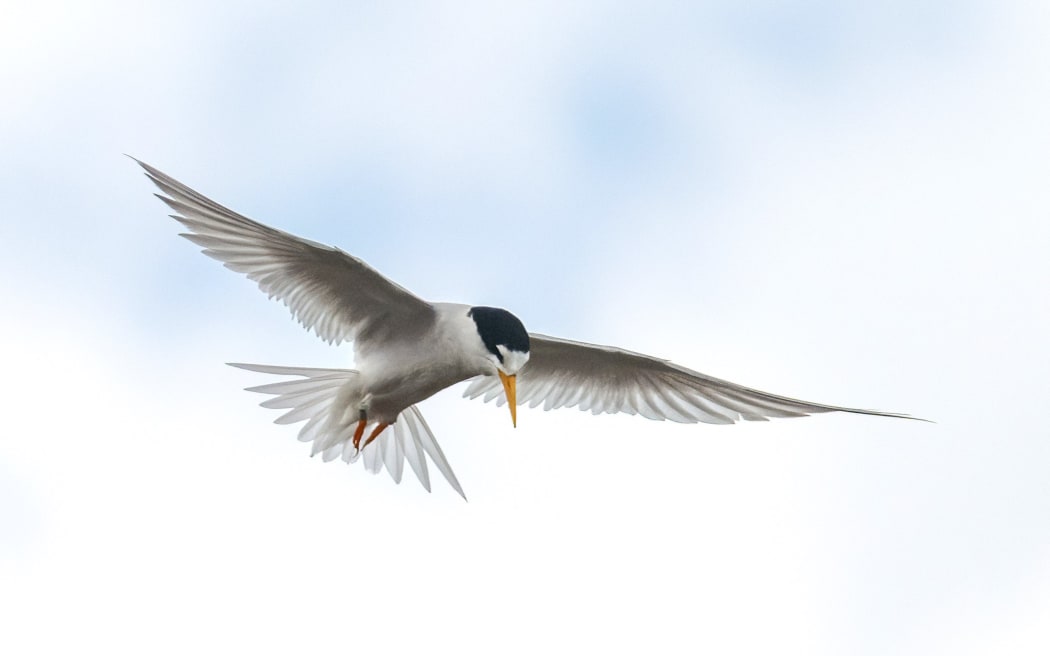
The tara iti or fairy tern, in flight. Photo: Supplied / Darren Markin
Ogle said numbers had fallen so low because the ecosystems they needed had been hugely compromised by human development.
Threats included overfishing, sedimentation, ocean warming and extreme weather.
"And when their environment changes naturally, they don't have anywhere else because where they would normally go has been developed and is no longer safe for them. They're quite restricted to places we also want to be as humans, because it's fun to play in estuaries and drive over dunes."
People who wanted to help the birds should keep out of fenced-off nesting areas and keep their dogs on a leash, or keep their pets off beaches they were not supposed to be on.
Another threat to tara iti was people leaving bait or fish frames on the beach. That attracted sea gulls which could then predate fairy tern chicks.
"Four-wheel-driving is another massive one. These birds are tiny in comparison to a four-drive wheel. Sometimes they'll hunker, sometimes they'll try and attack the vehicle. They're very determined parents, but if you drive over that nest you probably wouldn't even notice it."
Anyone who was harassed by a bird on a beach was probably too close to its nest.
"Most of our shorebirds are very, very good parents, and they will run into the fire to try and protect their children. So if you just back away when they're doing that to you, you'll give them the space they need to bring the next generation through."
Ogle hoped tara iti numbers would one day reach a point that such intensive intervention was no longer needed.
"It would be amazing if we didn't have to monitor every single site they nest at every single summer, which would mean that they're doing it on their own and they don't need our help. And that's the ultimate goal - to put ourselves out of a job because they can do it themselves."
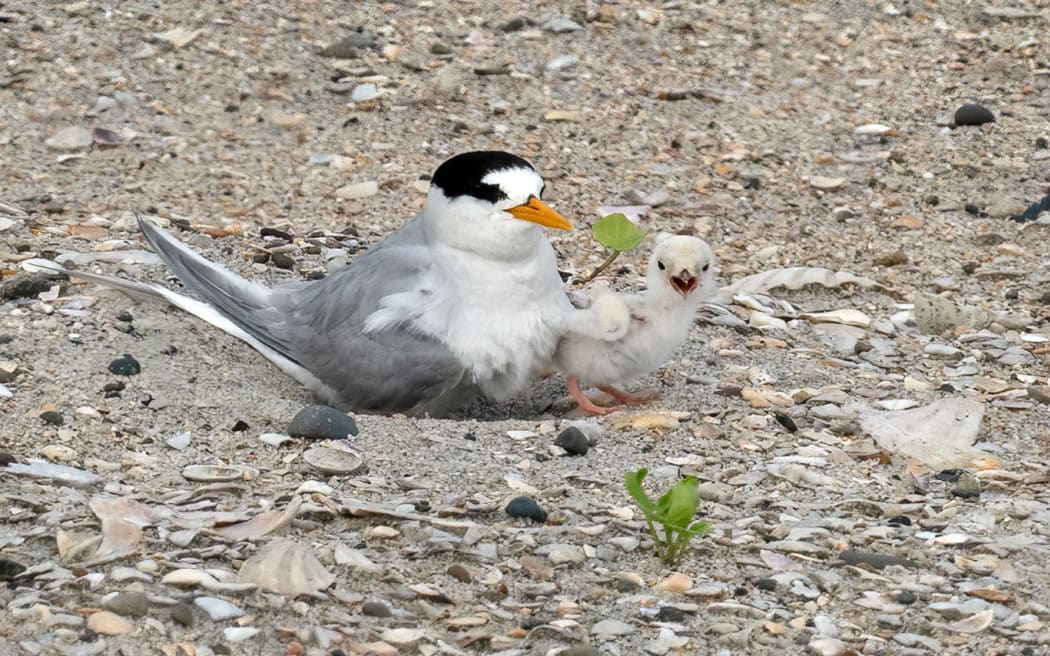
A tara iti chick steps briefly out of its nest at Waipū to explore. Photo: Supplied / Darren Markin

